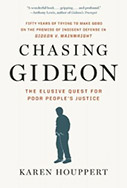Chasing Gideon: The Elusive Quest for Poor People’s Justice
 Author: Karen Houppert
Author: Karen Houppert
Publisher: New York: New Press, 2013. 288p.
Reviewer: Abbe Smith | July 2013
The recent golden anniversary of Gideon v. Wainwright, March 18, 2013, received lots of attention—at least in some circles. 50th anniversary conferences and symposia were essentially full-time employment for a handful of criminal lawyers and scholars this past year, perhaps especially Abe Krash, the surviving member of Clarence Earl Gideon’s Supreme Court legal team. Yet, given the sorry state of indigent defense, there was more hand-wringing than celebration. Fifty years after Gideon, we still haven’t come close to meeting the promise of the landmark decision, as articulated by the brilliant Anthony Lewis, Gideon’s chronicler,who, poignantly, died a week after the anniversary:
It will be an enormous task to bring to life the dream of Gideon v. Wainwright—the dream of a vast, diverse country in which every person charged with a crime will be capably defended, no matter what his economic circumstances, and in which the lawyer representing him will do so proudly, without resentment at an unfair burden, sure of the support needed to make an adequate defense. Anthony Lewis, Gideon’s Trumpet 205 (1964).
In Chasing Gideon: The Elusive Quest for Poor People’s Justice, journalist Karen Houppert shows that our vast, diverse country—from Spokane, Washington, to New Orleans, Louisiana, to Covington, Georgia—provides no guarantee whatsoever that a poor person charged with a crime will be capably defended, nor that the appointed lawyer will have the support necessary to provide a meaningful defense. To the contrary, Houppert shares tales of poor defendants languishing in jail with no counsel (p. 127-131), public defenders lacking even a list of the excessive number of clients they represent (p. 125), feckless court-appointed lawyers who do virtually nothing for their clients (pp. 15-20, 120-21), and poor, disproportionately nonwhite people jailed for months pretrial because of a bail system that benefits only the bail bonds industry (pp. 16-47). All of this contributes to the U.S. criminal justice system having become a “system of pleas, not a system of trials,” Lafler v. Cooper, 566 U.S. __ (2012)—or worse, as law professor Pamela Metzger is quoted as saying in the book, “’an illicit system of plea extortions and punishment without trial.’” (p. 113).
The heart of Houppert’s book is a lengthy chapter on indigent defense in New Orleans, before and after Katrina, which includes the story of the wrongful conviction of two innocent men, Greg Bright and Earl Truvia, for the drug-related murder of a teenage boy. Bright encountered virtually all of the systemic problems that continue to plague the criminal justice system in Louisiana and beyond: inadequately funded public defense, the failure of police and prosecutors to disclose exculpatory evidence, prosecutorial abuse of power generally, no right to counsel for appeals, collusion between judges, prosecutors, and defenders, and plain old racism. (p. 110)
Bright’s lawyer was more than just feckless. This was a murder case based on the testimony of a single eyewitness who, it turns out, had a history of mental illness, drug addiction, and testimony-for-hire, and could not have possibly seen what she claimed to have seen (pp. 163-67). It was also a case in which the client had a strong claim of factual innocence, supported by several alibi witnesses. But the defense lawyer’s opening statement consisted of one sentence: “’If your Honor please, Mr. Bright relies on his presumption of innocence.’” Then he sat down. (p. 122).
The lawyer put on no defense case—not a single witness—even though there were eight subpoenaed defense witnesses in the courthouse hallway waiting to be called to testify. (p. 139). When Bright asked why, the lawyer said that calling alibi witnesses would “’aggravate the jury, who…were tired and aggravated that the trial was taking so long.’” (p. 139) Meanwhile, the murder trial lasted less than two hours. (p. 139)
Houppert’s treatment of criminal justice in New Orleans also includes the post-Katrina story of a more typical indigent criminal defendant: Clarence Jones. Accused of a burglary he likely committed—although Jones claimed he was in an alley by the abandoned house to relieve himself—Jones sat in jail for sixteen months waiting for an attorney to be assigned to represent him. The jail he sat in was actually a tent—erected after the hurricane to house as many as 400 detainees. (p. 153). Houppert also tells the shockingly ordinary story of Willie Cheneau Jr., a man who sat in the Orleans Parish Prison for nearly two months for lack of $180 bond for possessing a nickel bag of marijuana, which was charged as a felony because it was his second arrest for drug possession.
Houppert illustrates why, guilty or not, you wouldn’t want to be arrested in Louisiana. Along with wretched conditions of confinement, Louisiana has some of the harshest sentencing laws in the country, including mandatory life without parole for three drug convictions (p. 140). In 2012, one out of every eight-six residents was doing time (p. 140), the majority in private prisons run by sheriffs or private companies whose chief concern is cutting costs and making a profit. (p. 141). Louisiana leads the country in imprisoning more of its residents per capita than any other state. (p. 139)
It’s not all depressing stuff. Houppert shares stories about lawyers who make a difference for their clients, sometimes even obtaining vindication. There is public defender Carol Dee Huneke, who takes on the entire court system in Spokane in order to obtain the time she needs to prepare for a vehicular manslaughter trial on behalf of a high school student with no criminal record who was in a car accident involving an elderly man who later died. (pp. 22-36) The young man is acquitted (p. 39). There is the young, “hard-working, smart, and dedicated” capital defender Joseph Romond (p. 233), trying his first death penalty case, and giving everything he has to save the life of a poor, mentally limited client who killed his ex-girlfriend’s son in the misguided belief that she would then return to him (p. 233-47). There is Innocence Project New Orleans director Emily Bolton, who decides to focus on lifers who have no right to post-conviction counsel instead of death row inmates, and manages to obtain Bright and Truvia’s release (160-67). New Orleans clinical law professors Pamela Metzger and Steve Singer, together with their students and a corps of volunteers, manage to clear the backlog of cases in New Orleans after Katrina, ushering in an era of reform (p. 123-131). But even these heroic stories have a bitter underside. Huneke is later fired from the public defender’s office—apparently for refusing to try another case because she wasn’t ready. (pp. 49-51). The stress of Romond’s work—the “’pressure of having someone’s life in your hands’” (p. 228)—becomes unbearable. He questions everything he does in court, and cries himself to sleep. (p. 228) When his client is ultimately sentenced to death, he is “disillusioned and dispirited,” quits his job with the Georgia Capital Defenders, moves to California, and takes a job as a bartender. He reports that he now drinks much less than he did as a lawyer. (p. 247)
It’s an important book: the reality of our much vaunted criminal justice system needs to be documented, the myth of equal justice before the law debunked. And the book provides a lot of important data about mass incarceration, our aging prison population, and the disproportionate impact our criminal justice policies have had on nonwhite communities.
But it is unevenly written (Houppert uses the words “folks” and “cops” excessively, and sometimes uses awkward language, like the word “aforementioned”), and the book can feel like a hodge-podge of odd criminal justice cases. The randomness of the cases may not be Houppert’s fault; but it is unclear why she picks these particular cases to write about. The chapter on the Gideon decision and its cast of characters breaks no new ground (except for suggesting that a lawyer named Joseph Peel who served time with Gideon in Raiford prison might have assisted Gideon in his Supreme Court writ) and felt shallow. The basic details are accurate but much more could have been done with both the strategic decisions in the Supreme Court litigation and the subsequent retrial. In a throw-away line, Houppert asserts that Gideon remains a “helpful tool to hold over state and local governments who routinely underfund public defender programs” (p. 75), but she never says how. To the contrary, she shows widespread circumvention of Gideon by states and localities.
It might have been interesting to learn something about some of the 2,000 Florida prisoners who were freed as a result of Gideon v. Wainwright. One of the ways we might begin to meet the promise of Gideon would be to downsize the criminal justice system, not prosecuting some offenders and/or releasing others—especially some of our aging prisoners (like the 4,500 aging Angola prisoners serving life without the possibility of parole) (p. 141). If there were fewer criminal defendants—and fewer prisoners—the cost of supplying adequate counsel would be less.
Houppert asks a question that begs to be answered more fully: “How do we have a conversation about indigent defense that allows human complexities to exist right alongside the fundamental notion that all poor are ‘deserving poor’ and thus entitled to due process?” (p. 97) It is important to remember that Clarence Earl Gideon “spent his life in and out of prison” (p. 99), and was not necessarily factually innocent, even though he was wrongfully convicted. There are probably too many stories about innocent people. Bright and Truvia, who spent years in prison for something they didn’t do, and Sean Replogle, the high school student who still looks like a “nervous…skinny eighteen-year-old” ten years after his acquittal for vehicular homicide (p. 51), are not ordinary criminal defendants. The story of a 12-year-old boy who pleads guilty to molesting a 5-year-old neighbor by sticking his hands down the younger boys pants—following the advice of a beleaguered public defender who spent no more than an hour and a half with his client and who filed no motions and conducted no investigation—comes closer (pp. 18-19). In addition to receiving time, the 12-year-old had to register as a sex offender (p. 19). So does the story about alleged burglar Clarence Jones. Yes, the right to counsel—if it is meaningful, if it means more than a warm body at counsel table—protects us from convicting the innocent. But the right to counsel is more fundamental to our system of justice than that. It means that everyone—even people who may have done very bad things—have the right to able counsel.
Like the recent documentary Gideon’s Army (HBO Documentary Films, 2013), Chasing Gideon leaves the reader feeling deflated if not entirely hopeless. The most distressing message is that even extraordinary lawyers who are committed to fulfilling Gideon’s promise too often labor under conditions that doom them to fail. Chasing Gideon illustrates that, 50 years after Gideon, if you are poor and accused of a crime, chances are you are not going to get very good representation. As Steve Bright said on the 35th anniversary of Gideon, “[W]e ought to just say that our system of justice is like the sky box at the stadium, or membership in the country club—available only to people who can afford it.’” Bob Herbert, Cheap Justice, N.Y. Times, March 1, 1998, at WK 15 (quoting Bright).
Abbe Smith is Professor of Law, Director of the Criminal Defense & Prisoner Advocacy Clinic, and Co-Director of the E. Barrett Prettyman Fellowship Program, Georgetown Law School.


